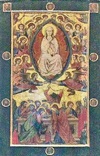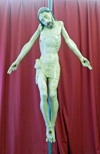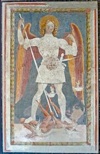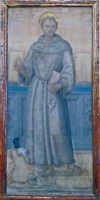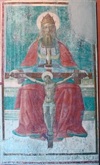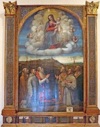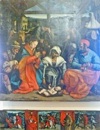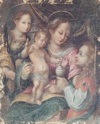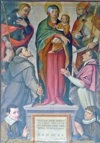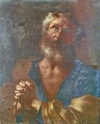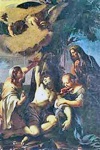

Benedetto di Bindo (died 1417)
Benedetto di Bindo established his career in Siena before moving to Perugia in ca. 1415. He died prematurely two years later and was buried in San Domenico there. This altarpiece (early 15th century) of the Assumption of the Virgin from Santa Maria Maggiore, which is now in the Pinacoteca Civica, is attributed to him.
Agostino di Duccio (died ca. 1481)
This figure of the crucified Christ in the Pinacoteca Comunale is attributed to Agostino di Duccio. The friars of the Chiesa di San Crispolto bought it from the friars of San Francesco al Prato, Perugia in 1800.
Bartolomeo Caporali (died after 1505)
This detached fresco (15th century) of St Michael from the Chiesa di San Crispolto has traditionally been attributed to Fiorenzo di Lorenzo (below), but it has recently been assigned to Bartolomeo Caporali. The fresco, which depicts the standing St Michael weighing the souls of the dead while killing a dragon, is now in the Pinacoteca Civica.
Fiorenzo di Lorenzo (c. 1440 - 1522)
From Perugia
See Bartolomeo Caporali above.
[Temporary link to Fiorenzo di Lorenzo]
Pietro Vannucci, il Perugino (1446–1524)
This altarpiece (ca. 1512) of St Antony of Padua, which is signed by Perugino, came from the Convento di Sant’ Antonio da Padova and is now in the Pinacoteca. A second altarpiece (ca. 1512) from the same convent, which is also in the Pinacoteca, is attributed to him. It depicts the Madonna della Misericordia with SS Stephen and Jerome and two kneeling donors.
Tiberio d’ Assisi (ca. 1465-1524)
Two frescoes (ca. 1503), which are attributed to Tiberio d’ Assisi, were detached from the ruined church of San Simeone, Tor d’ Andrea (on the borders with Assisi) in the early 20th century and are are now in the Pinacoteca Civica:
-
✴One (illustrated here) depicts the Trinity: the seated God the Father holds a Crucifix, with the Holy Spirit in the form of a dove above it. A now-lost inscription of the date “1503” was recorded on it in the 19th century.
-
✴In the other fresco, the standing St Roch is dressed as a pilgrim and displays the scars from the plague on his thigh.
Jacopo Siculo (1490-1544)
This altarpiece (1547) of the Madonna and Child in Glory with saints, which attributed to the workshop of Jacopo Siculo, was completed three years after his death. It came from the high altar of the Convento di Sant’ Antonio da Padova and is now in the Pinacoteca Civica. The predella contains images of the donors and identifying inscriptions: Donna Ciancia Angelini commissioned the work according to the will of her husband, Giuliano in 1547.
Dono Doni (1505-75)
This altarpiece (16th century) of the Adoration of the Shepherds, which is attributed to Dono Doni, was documented in the Chiesa di San Crispolto in the 19th century and is now in the Pinacoteca Civica. In the main panel, the Virgin, an elderly nurse and St Joseph together with three shepherds, kneel in a semi-circle behind the baby Jesus, who lies on the floor of the stable in which He was born. The predella contains scenes from the life and martyrdom of St Crispoltus.
Benedetto Bandiera (1557-1634)
Two panels (17th century) in Bettona are attributed to Benedetto Bandiera:
-
✴one from the Biancalana Collection, which is now in the Pinacoteca Comunale, depicts the Madonna and Child with SS Mary Magdalene and Barbara; and
-
✴the other, in Santa Maria Maggiore, depicts the Crucifixion with SS Francis and Charles Borromeo.
Ascensidonio Spacca, il Fantino (1557-1646)
This altarpiece (1615) in Santa Maria Maggiore, which is signed and dated, came from San Rocco. It depicts the standing Madonna with SS Roch, Crispoltus, Francis and Charles Borromeo and was painted only five years after the canonisation of the last of these. The half-length portraits at the bottom depict the artist and the unknown donor.
Antonio Maria Fabrizi (1595-1649)
Antonio Maria Fabrizi, who probably trained in Rome, subsequently worked in his native city. This altarpiece (17th century) in the Pinacoteca, which is of unknown provenance, is attributed to him. It depicts St Peter crying after his betrayal of Christ.
Cesare Sermei (1584- 1668)
From Orvieto; trained in Rome; moved to Assisi
36 frescoes (ca. 1615) by Cesare Sermei, which depicted scenes from the life of St Crispoltus, were destroyed when the church was remodelled in 1797. The original designs by Sermei survive in Assisi and copies (1797) remain in the church.
[Temporary link to Cesare Sermei.]
Giacinto Boccanera (1666-1746)
Giacinto Boccanera painted this model (1689) for the altarpiece in the Duomo, Città delle Pieve shortly after he finished training in Rome, and before he settled in Perugia. The panel, which is now in the Pinacoteca of Bettona, is one of his earliest known signed works.
Gerardo Dottori (1884-1977)
Gerardo Dottori, who was a prominent exponent of Futurism, served as Director of the Accademia di Belle Arti di Perugia in 1940-7. He painted these frescoes (1939) of the Virgin and Angels in the apse of Santa Maria Maggiore.


